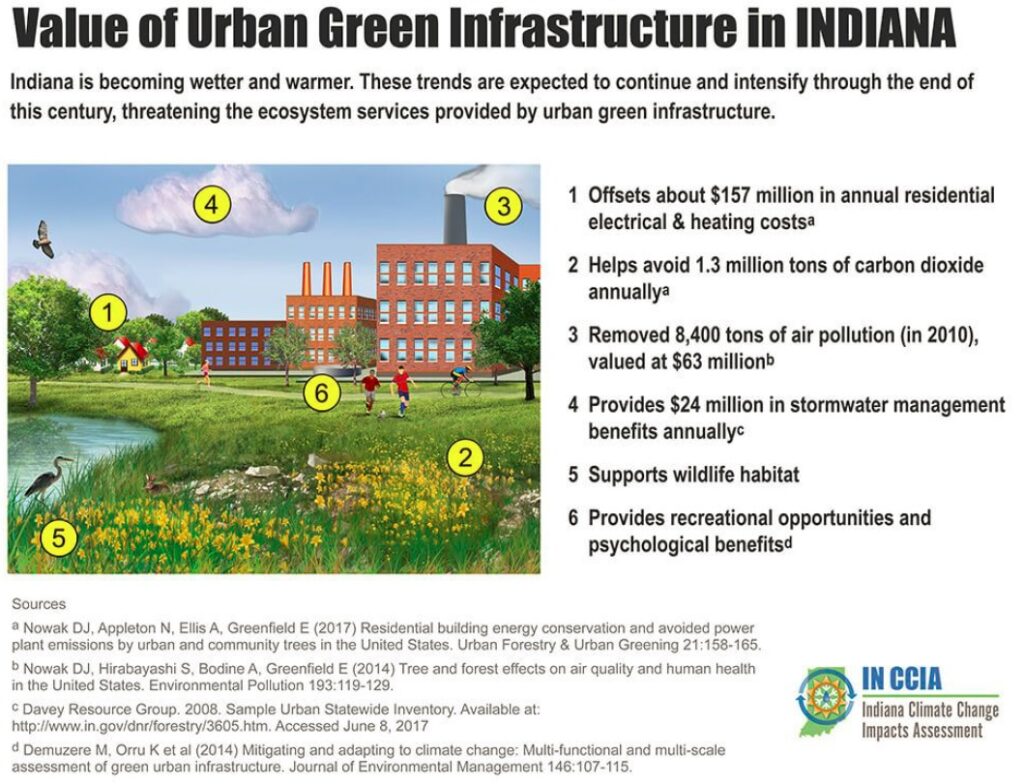From Maintaining Indiana’s Urban Green Spaces: A Report from the Purdue University Indiana Climate Change Impacts Assessment
Reynolds, H., Brandt, L., Widhalm, M., Fei, S., Fischer, B., Hardiman, B., Moxley, D., Sandweiss, D., Speer, J., and J.S. Dukes. (2018). Maintaining Indiana’s Urban Green Spaces: A Report from the Indiana Climate Change Impacts Assessment. Purdue Climate Change Research Center, Purdue University. West Lafayette, Indiana. DOI: 10.5703/1288284316653
Benefits of Urban Green Infrastructure
Urban green spaces offer economic, environmental and health benefits to Indiana cities and their residents.
Trees can significantly affect a city’s microclimate by providing shade, evaporative cooling and windbreaks. In Indiana, urban trees save about $157 million annually in residential electrical and heating costs, and they help avoid 1.3 million tons of carbon dioxide emissions annually (Nowak et al., 2017).

Above : A summary of community and personal benefits of urban green infrastructure in the state of Indiana.
Urban trees play an essential role in urban air quality, too. It was estimated that Indiana’s urban trees removed 8,400 tons of air pollution in 2010, at a value of $63 million. Tree canopy loss due to climate-related stressors can reduce the ability of urban trees to filter the air.
Urban trees and other vegetation increase the amount of porous ground that can take up rain and melting snow and keep water from overburdening storm sewers. It’s estimated that urban trees provide about $24 million in stormwater management benefits to the state annually. Riparian buffers, bioswales, rain gardens and other green drainage infrastructure can also retain or redirect precipitation that would otherwise travel over impervious surfaces to storm drains.
Urban trees and green spaces also provide opportunities for recreation, relaxation and social engagement, supporting physical and mental health as well as community building.
Green roofs–roofs adapted to allow for growth of plants–are an underutilized method of stormwater retention. They also lengthen the life of a roof, decrease heating and cooling costs for the building, reduce noise and air pollution, and provide habitat for pollinators.
Many wildlife species benefit from urban green spaces. Woody species such as oaks, poplars, maples, blueberries and spruces support caterpillars, and urban forests can provide important “stopover” habitat for migrating birds. Prairie plantings of all sizes, including curbside plantings and small “pocket prairies,” can attract pollinators and native birds.
Compared to the turfgrass species used for lawns, prairie vegetation can capture and absorb more runoff. It also requires less fossil fuel, water and fertilizers than traditional lawns and landscaping, which reduces environmental impacts and saves money.
Urban farm plots, including community gardens, orchards and rooftop gardens offer the opportunity to grow fresh fruits and vegetables. They also reduce the amount of shipping necessary to deliver food to consumers, potentially reducing a city’s carbon footprint (the amount of CO2 emitted from using fossil fuels like coal and oil).
For more information, including the Indiana Tree Habitat Suitability in 2100, see the full report.
